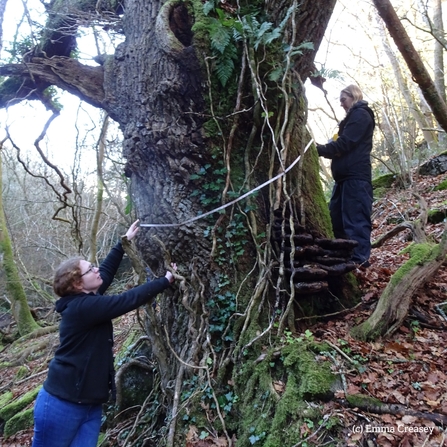‘The girth is three point eight metres.’
‘Wow, that’s the biggest so far!’
This is Avon Wildlife Trust’s (AWT) monitoring team, and they are looking for Ancient and Veteran Trees.
Why? you might ask – indeed, several puzzled dog-walkers already have. The answer is that ancient trees are special – and very important.
Why are ancient trees important?
All trees are a vital habitat, providing shelter and food for all kinds of creatures. As they mature and change, the wildlife they can host changes too. Old bark develops crevices and holes, that might be used by woodpeckers, bats or dormice. Eventually, the tree’s heartwood begins to die, and it hollows out from the inside. Not only does this provide valuable nesting space, but the decaying wood hosts unique species of fungi and insects that can live nowhere else. These include the oak polypore fungus, which only grows on ancient oaks, and the violet click beetle whose grubs feed on the wood. A tree that has reached this ‘ancient’ stage, therefore, is very precious.
In the UK, we have a particular responsibility to look after this unique resource; an astonishing 90% of all the ancient trees in Europe are here in our little island. The reason for this is surprising – the survival of British aristocracy! In countries where uprisings and revolution ousted the nobility, their estates were opened up to common use, with the result that trees were used for timber and firewood. Here in the UK, estates survived behind enclosing walls, and most of our ancient trees are in forests that were once a gentleman’s property. Undemocratic perhaps, but good news for the trees and the wildlife within them, which thrived under this aristocratic protection.
Old trees can also tell us how land was used in the past. A suspiciously straight line of gnarled hawthorn and field maple may reveal an ancient boundary. A tree with wide, spreading branches growing in the middle of a wood shows that it once grew in an open field, with room to stretch. Trees are part of our history, as much as castles and cathedrals, and ought to be cherished and preserved in the same way.
Sadly, ancient trees have no legal protection in the UK and as more land is sold to developers, many are being lost. So Avon Wildlife Trust is on a mission to find as many as it can on its own reserves – and that’s where the monitoring team comes in.



